Both Forest Harvesting and Hydropower Dams Yielded Negative Impact on Low Flow Regimes in the Zagunao River Watershed, Southwest China
Abstract
1. Introduction
2. Materials and Methods
2.1. Watershed Description
2.2. Data
2.3. Definitions of Low Flow Regime Components
2.4. Trend and Change Point Analysis
2.5. Quantification of the Impact of Forest Harvesting and Hydropower Dams on Low Flow Regimes
3. Results
3.1. Long-Term Changes of Climate and Low Flow Regimes
3.2. Forest Harvesting Effects on Low Flow Regimes
3.2.1. Magnitude
3.2.2. Return Period
3.2.3. Timing
3.2.4. Variability
3.2.5. Duration
3.3. Effects of Hydropower Dam on Low Flow Regimes
3.3.1. Magnitude
3.3.2. Return Period
3.3.3. Timing
3.3.4. Variability
3.3.5. Duration
4. Discussion
4.1. Impact of Forest Harvesting on Low Flow Regimes
4.2. Impact of Hydropower Dams on Low Flow Regimes
4.3. Ecological Implications for Watershed Management
4.4. Limitations and Future Studies
5. Conclusions
Author Contributions
Funding
Conflicts of Interest
Appendix A
| Components | Definitions |
|---|---|
| Magnitude | The amount of water moving past the watershed outlet per day (m3/s); Low flows: Daily flows ≤ Q95%. |
| Frequency | How often a flow above a given magnitude recurs over specified time interval, for example, a 50-year flood is equaled to or exceeded on average once every 50 years; Low flows: Return period of low flows. |
| Timing | The time for a given flow event (e.g., annual peak flow) that occurs regularly. It is also referred as predictability of a given flow event; Low flows: Average date for low flows in a water year. |
| Variability | Variations of flows describing how spread out or closely clustered of flow magnitude. Coefficient of variation is often used to measure variability for a set of data; Low flows: Coefficient of variation for low flows at each year. |
| Duration | The period for given flow events (e.g., low flows) last; Low flows: The number of days with daily flows equal to or less than low flow threshold (low flow threshold: Median of low flows during reference period 1959–1968). |
| Variables | 1959–1975 | 1959–1988 | 1959–1996 | 1989–2006 | 1959–2006 | ||||||
|---|---|---|---|---|---|---|---|---|---|---|---|
| Kendall | Spearman | Kendall | Spearman | Kendall | Spearman | Kendall | Spearman | Kendall | Spearman | ||
| Precipitation | Annual | −0.125 | −0.121 | −0.152 | −0.202 | −0.064 | −0.102 | −0.275 | −0.404 | −0.141 | −0.204 |
| Dry season | −0.229 | −0.315 | −0.094 | −0.138 | 0.037 | 0.063 | −0.275 | −0.403 | −0.007 | −0.01 | |
| Wet season | −0.125 | −0.116 | −0.23 | −0.282 | −0.144 | −0.187 | −0.249 | −0.355 | −0.186 | −0.25 | |
| Low flow period | 0.125 | 0.202 | 0.41 | 0.046 | 0.027 | 0.041 | −0.079 | −0.085 | 0.007 | 0.024 | |
| Tmax | Annual | 0.03 | 0.08 | 0.300 * | 0.446 * | 0.265 * | 0.391 * | 0.092 | 0.117 | 0.250 * | 0.371 ** |
| Dry season | 0.037 | 0.033 | 0.174 | 0.256 | 0.063 | 0.087 | −0.131 | −0.151 | 0.064 | 0.094 | |
| Wet season | 0.03 | 0.08 | 0.300 * | 0.446 * | 0.265 * | 0.391 * | 0.092 | 0.117 | 0.250 * | 0.371 ** | |
| Low flow period | −0.229 | −0.315 | −0.005 | −0.004 | −0.026 | −0.05 | −0.238 | −0.395 | −0.025 | −0.04 | |
| Tmean | Annual | −0.044 | −0.063 | 0.152 | 0.193 | 0.131 | 0.161 | −0.236 | −0.375 | 0.144 | 0.198 |
| Dry season | −0.281 | −0.409 | −0.005 | −0.021 | −0.029 | −0.054 | −0.304 | −0.392 | 0.027 | 0.039 | |
| Wet season | 0.36 | 0.495 * | 0.285 * | 0.405 * | 0.235 * | 0.353 * | −0.08 | −0.078 | 0.251 * | 0.382 ** | |
| Low flow period | −0.252 | −0.373 | −0.007 | −0.034 | −0.053 | −0.084 | −0.223 | −0.329 | −0.02 | −0.029 | |
| Tmin | Annual | −0.189 | −0.223 | −0.129 | −0.15 | −0.1 | −0.115 | −0.185 | −0.328 | −0.022 | −0.024 |
| Dry season | −0.189 | −0.223 | −0.129 | −0.15 | −0.1 | −0.115 | −0.185 | −0.328 | −0.022 | −0.024 | |
| Wet season | 0.007 | 0.034 | −0.14 | −0.177 | −0.15 | −0.193 | −0.159 | −0.184 | −0.068 | −0.072 | |
| Low flow period | −0.286 | −0.442 | −0.134 | −0.22 | −0.136 | −0.221 | −0.08 | −0.11 | −0.042 | −0.07 | |
| Rhu | Annual | −0.134 | −0.233 | −0.215 | −0.319 | −0.089 | −0.138 | 0.238 | 0.343 | −0.121 | −0.181 |
| Dry season | −0.12 | −0.164 | −0.14 | −0.212 | 0.001 | −0.018 | 0.399 * | 0.541 * | 0.002 | −0.005 | |
| Wet season | 0.067 | 0.108 | −0.127 | −0.174 | −0.132 | −0.177 | 0.046 | 0.1 | −0.16 | −0.213 | |
| Low flow period | −0.156 | −0.26 | −0.237 | −0.331 | −0.09 | −0.133 | 0.430 * | 0.622 ** | −0.04 | −0.049 | |
| Win | Annual | 0.015 | 0.022 | 0.07 | 0.095 | −0.026 | −0.03 | −0.007 | −0.001 | −0.11 | −0.162 |
| Dry season | 0.067 | 0.104 | 0.1 | 0.148 | −0.006 | 0.006 | −0.125 | −0.163 | −0.113 | −0.158 | |
| Wet season | −0.096 | −0.097 | −0.03 | −0.024 | −0.099 | −0.123 | 0.02 | 0.035 | −0.155 | −0.215 | |
| Low flow period | 0.172 | 0.26 | 0.127 | 0.201 | −0.018 | −0.006 | −0.268 | −0.334 | −0.147 | −0.184 | |

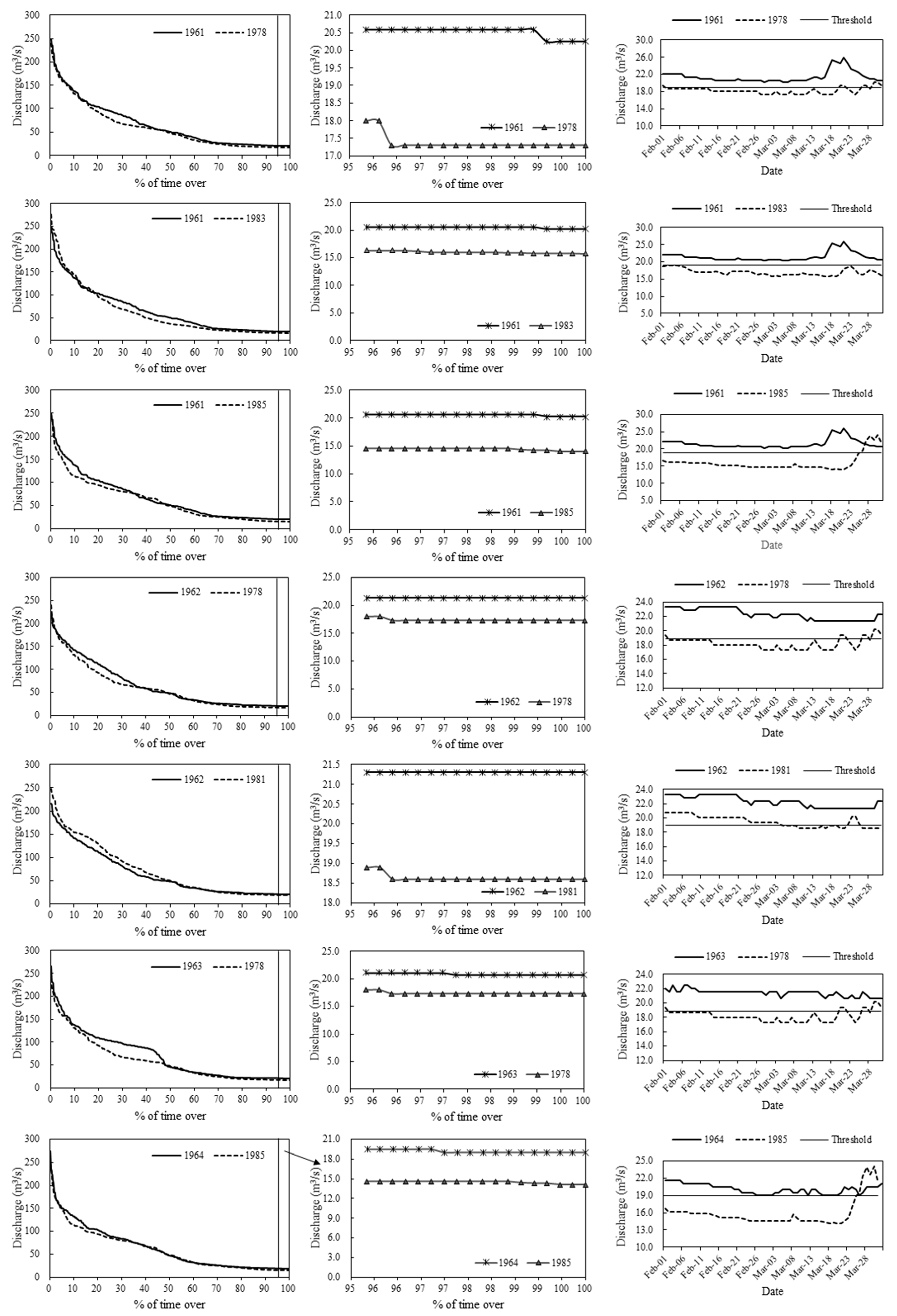
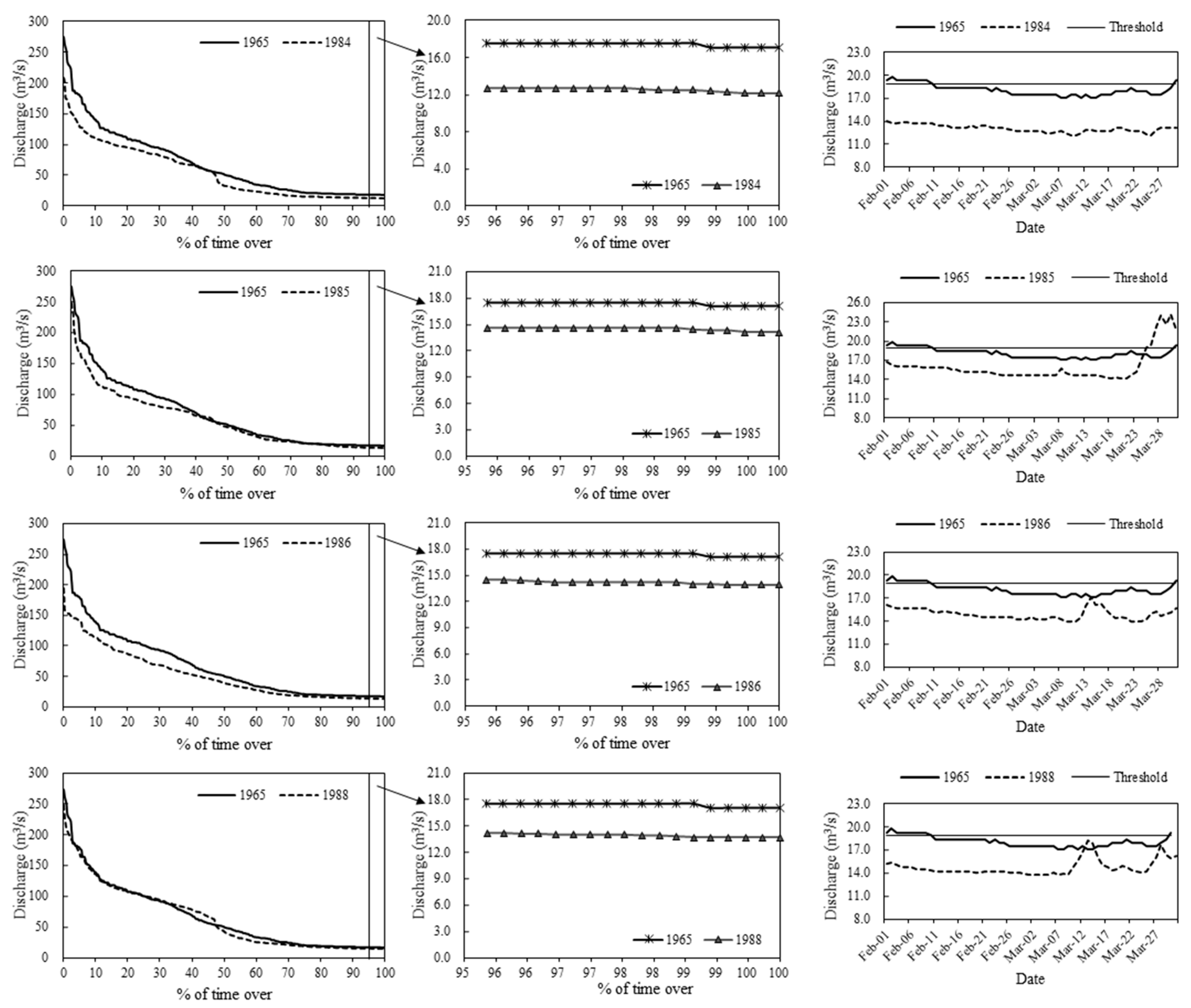
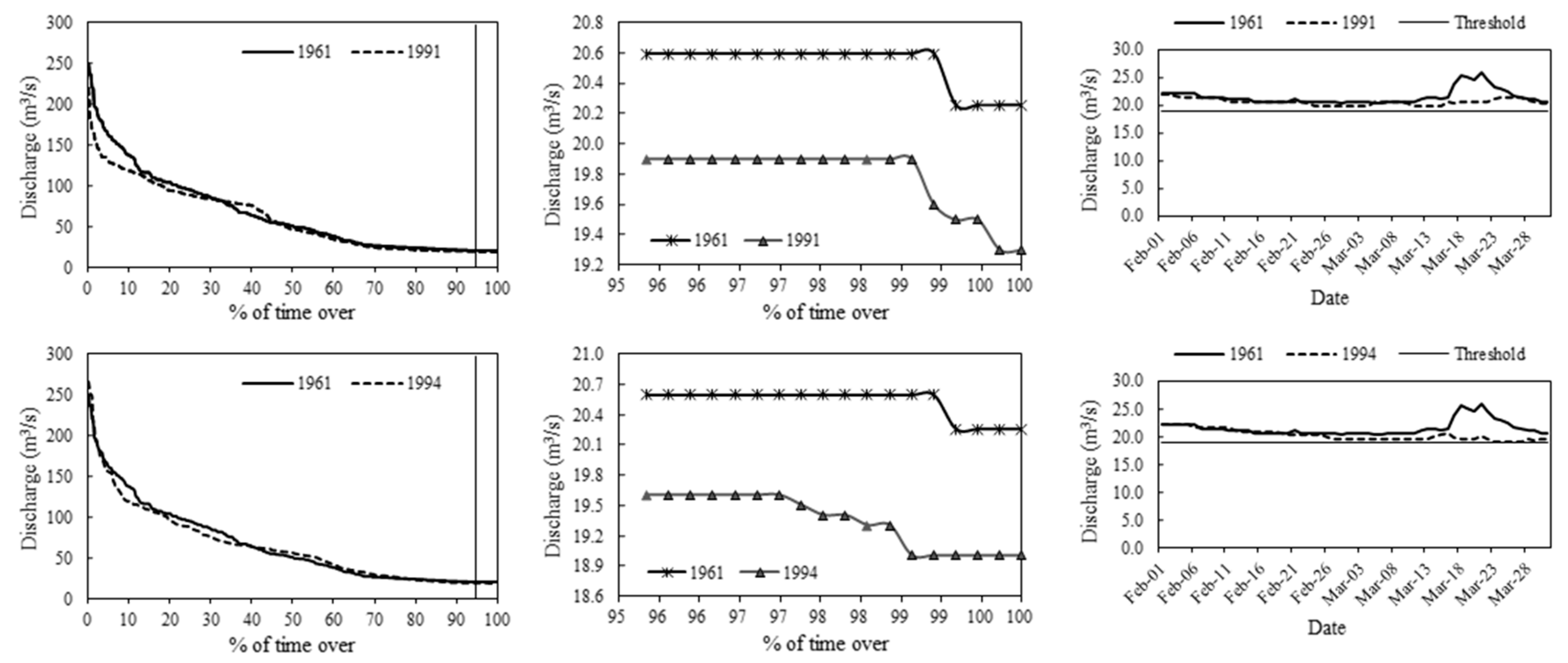

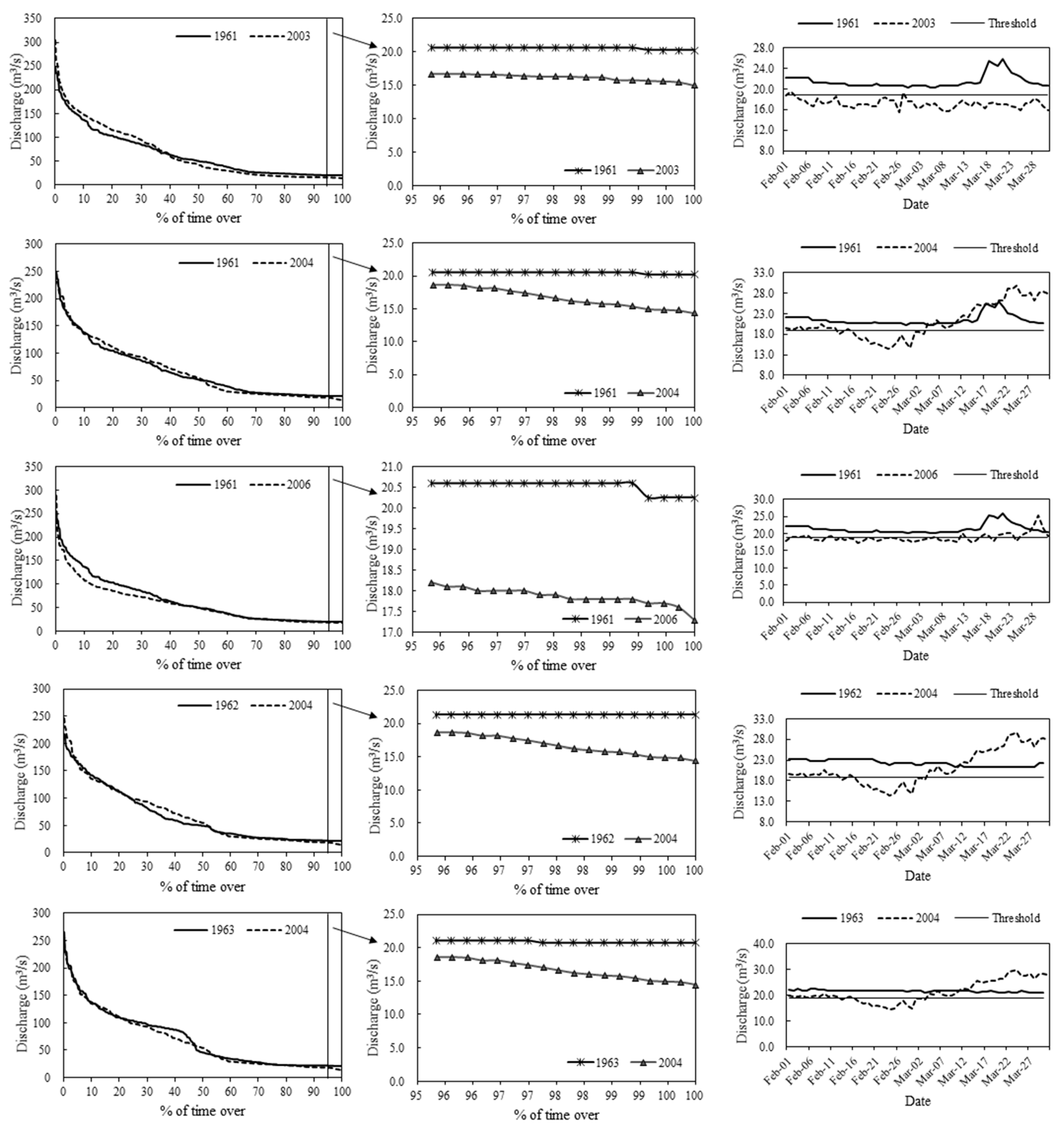
References
- Zhang, M.; Wei, X. Alteration of flow regimes caused by large-scale forest disturbance: A case study from a large watershed in the interior of British Columbia, Canada. Ecohydrology 2013, 7, 544–556. [Google Scholar] [CrossRef]
- Zhang, M.; Wei, X.; Li, Q. A quantitative assessment on the response of flow regimes to cumulative forest disturbances in large snow-dominated watersheds in the interior of British Columbia, Canada. Ecohydrology 2016, 9, 843–859. [Google Scholar] [CrossRef]
- Hart, D.D.; Finelli, C.M. Physical-Biological Coupling in Streams: The Pervasive Effects of Flow on Benthic Organisms. Annu. Rev. Ecol. Syst. 1999, 30, 363–395. [Google Scholar] [CrossRef]
- Poff, N.L.; Allan, J.D.; Bain, M.B.; Karr, J.R.; Prestegaard, K.L.; Richter, B.; Sparks, R.E.; Stromberg, J.C. The Natural Flow Regime. BioScience 1997, 47, 769–784. [Google Scholar] [CrossRef]
- Poff, N.L.; Zimmerman, J.K.H. Ecological responses to altered flow regimes: A literature review to inform the science and management of environmental flows. Freshw. Biol. 2010, 55, 194–205. [Google Scholar] [CrossRef]
- Schneider, C.; Laize, C.; Acreman, M.C.; Florke, M. How will climate change modify river flow regimes in Europe. Hydrol. Earth Syst. Sci. 2012, 17, 325–339. [Google Scholar] [CrossRef]
- Montgomery, W.L.; McCormick, S.D.; Naiman, R.J.; Whoriskey, J.F.G.; Black, G.A. Spring migratory synchrony of salmonid, catostomid, and cyprinid fishes in Rivière à la Truite, Québec. Can. J. Zool. 1983, 61, 2495–2502. [Google Scholar] [CrossRef]
- Sparks, R.E. Need for Ecosystem Management of Large Rivers and Their Floodplains. BioScience 1995, 45, 168–182. [Google Scholar] [CrossRef]
- Tealdi, S.; Camporeale, C.V.; Ridolfi, L. Long-term morphological river response to hydrological changes. Adv. Water Resour. 2011, 34, 1643–1655. [Google Scholar] [CrossRef]
- Belmar, O.; Bruno, D.; Martinezcapel, F.; Barquin, J.; Velasco, J. Effects of flow regime alteration on fluvial habitats and riparian quality in a semiarid Mediterranean basin. Ecol. Indic. 2013, 30, 52–64. [Google Scholar] [CrossRef]
- Merritt, D.M.C.; David, J. Riparian vegetation and channel change in response to river regulation: A comparative study of regulated and unregulated streams in the Green River Basin, USA. Regul. Rivers Res. Manag. 2000, 16, 543–564. [Google Scholar] [CrossRef]
- Cooper, D.J.A.; Douglas, C.; Chimner, R.A. Multiple pathways for woody plant establishment on floodplains at local to regional scales. J. Ecol. 2003, 91, 182–196. [Google Scholar] [CrossRef]
- Agostinho, A.A.; Pelicice, F.M.; Gomes, L.C. Dams and the fish fauna of the Neotropical region: Impacts and management related to diversity and fisheries. Braz. J. Biol. 2008, 68, 1119–1132. [Google Scholar] [CrossRef] [PubMed]
- Lessard, J.; Hicks, D.M.; Snelder, T.H.; Arscott, D.B.; Larned, S.T.; Booker, D.J.; Suren, A.M. Dam Design can Impede Adaptive Management of Environmental Flows: A Case Study from the Opuha Dam, New Zealand. Environ. Manag. 2013, 51, 459–473. [Google Scholar] [CrossRef]
- Mcmanamay, R.A.; Frimpong, E.A. Hydrologic filtering of fish life history strategies across the United States: Implications for stream flow alteration. Ecol. Appl. 2015, 25, 243–263. [Google Scholar] [CrossRef]
- Choi, S.; Yoon, B.; Woo, H. Effects of dam-induced flow regime change on downstream river morphology and vegetation cover in the Hwang River, Korea. River Res. Appl. 2005, 21, 315–325. [Google Scholar] [CrossRef]
- Ma, L.; Zhang, X.; Wang, H.; Qi, C. Characteristics and Practices of Ecological Flow in Rivers with Flow Reductions Due to Water Storage and Hydropower Projects in China. Water 2018, 10, 1091. [Google Scholar] [CrossRef]
- Hu, W.; Wang, G.; Deng, W.; Li, S. The influence of dams on ecohydrological conditions in the Huaihe River basin, China. Ecol. Eng. 2008, 33, 233–241. [Google Scholar] [CrossRef]
- Fantin-Cruz, I.; Pedrollo, O.; Girard, P.; Zeilhofer, P.; Hamilton, S.K. Effects of a Diversion Hydropower Facility on the Hydrological Regime of the Correntes River, a Tributary to the Pantanal floodplain, Brazil. J. Hydrol. 2015, 531, 810–820. [Google Scholar] [CrossRef]
- Fu, C.; Wu, J.; Chen, J.; Wu, Q.; Lei, G. Freshwater fish biodiversity in the Yangtze River basin of China: Patterns, threats and conservation. Biodivers. Conserv. 2003, 8, 1649–1685. [Google Scholar] [CrossRef]
- Li, C. A Preliminary Analysis of the Impacts of the Cascade Hydropower Development on the Fish Biodiversity in the Upper Reach of the Yangtze River. Master’s Thesis, Huazhong University of Science & Technology, Wuhan, China, 2012. [Google Scholar]
- Kibler, K.M.; Tullos, D.D. Cumulative biophysical impact of small and large hydropower development in Nu River, China. Water Resour. Res. 2013, 49, 3104–3118. [Google Scholar] [CrossRef]
- Bruijnzeel, L.A. Hydrological functions of tropical forests: Not seeing the soil for the trees? Agric. Ecosyst. Environ. 2004, 104, 185–228. [Google Scholar] [CrossRef]
- Calder, I.R. Blue Revolution: Integrated Land and Water Resource Management; Routledge: Abingdon, UK, 2005; Volume 565, pp. 277–288. [Google Scholar]
- Moore, R.D.; Wondzell, S.M. Physical hydrology and the effects of forest harvesting in the Pacific Northwest: A review. J. Am. Water Resour. Assoc. 2005, 41, 763–784. [Google Scholar] [CrossRef]
- Liu, W.; Wei, X.; Fan, H.; Guo, X.; Liu, Y.; Zhang, M.; Li, Q. Response of flow regimes to deforestation and reforestation in a rain-dominated large watershed of subtropical China. Hydrol. Process. 2015, 29, 5003–5015. [Google Scholar] [CrossRef]
- Xu, Z.; Liu, W.; Wei, X.; Fan, H.; Ge, Y.; Chen, G.; Xu, J. Contrasting Differences in Responses of Streamflow Regimes between Reforestation and Fruit Tree Planting in a Subtropical Watershed of China. Forests 2019, 10, 212. [Google Scholar] [CrossRef]
- Bernsteinova, J.; Bassler, C.; Zimmermann, L.; Langhammer, J.; Beudert, B. Changes in runoff in two neighbouring catchments in the Bohemian Forest related to climate and land cover changes. J. Hydrol. Hydromech. 2015, 63, 342–352. [Google Scholar] [CrossRef]
- Yu, Z.; Sun, G.; Cai, T.; Hallema, D.W.; Duan, L. Water Yield Responses to Gradual Changes in Forest Structure and Species Composition in a Subboreal Watershed in Northeastern China. Forests 2019, 10, 211. [Google Scholar] [CrossRef]
- Robinson, M.; Dupeyrat, A. Effects of commercial timber harvesting on streamflow regimes in the Plynlimon catchments, mid-Wales. Hydrol. Process. 2005, 19, 1213–1226. [Google Scholar] [CrossRef]
- Eisenbies, M.H.; Aust, W.M.; Burger, J.A.; Adams, M.B. Forest operations, extreme flooding events, and considerations for hydrologic modeling in the Appalachians—A review. For. Ecol. Manag. 2007, 242, 77–98. [Google Scholar] [CrossRef]
- Webb, A.A.; Jarrett, B.W.; Turner, L.M. Effects of plantation forest harvesting on water quality and quantity Canobolas State forest NSW. In Proceedings of the 5th Australian Stream Management Conference, Australian Rivers: Making a Difference, Charles Sturt University, Thurgoona, New South Wales, 1 January 2007. [Google Scholar]
- Savary, S.; Rousseau, A.N.; Quilbe, R. Assessing the Effects of Historical Land Cover Changes on Runoff and Low Flows Using Remote Sensing and Hydrological Modeling. J. Hydrol. Eng. 2009, 14, 575–587. [Google Scholar] [CrossRef]
- Price, K.; Jackson, C.R.; Parker, A.J.; Reitan, T.; Dowd, J.F.; Cyterski, M. Effects of watershed land use and geomorphology on stream low flows during severe drought conditions in the southern Blue Ridge Mountains, Georgia and North Carolina, United States. Water Resour. Res. 2011, 47, 1–19. [Google Scholar] [CrossRef]
- Rientjes, T.H.M.; Haile, A.T.; Kebede, E.; Mannaerts, C.M.; Habib, E.; Steenhuis, T.S. Changes in land cover, rainfall and stream flow in Upper Gilgel Abbay catchment, Blue Nile basin—Ethiopia. Hydrol. Earth Syst. Sci. 2011, 15, 1979–1989. [Google Scholar] [CrossRef]
- Woodsmith, R.D.; Vache, K.B.; Mcdonnell, J.J.; Helvey, J.D. Entiat Experimental Forest: Catchment-scale runoff data before and after a 1970 wildfire. Water Resour. Res. 2004, 40, W11701.11701–W11701.11705. [Google Scholar] [CrossRef]
- Pettit, N.E.; Froend, R.H.; Davies, P.M. Identifying the natural flow regime and the relationship with riparian vegetation for two contrasting western Australian rivers. Regul. Rivers 2001, 17, 201–215. [Google Scholar] [CrossRef]
- Stromberg, J.C.; Beauchamp, V.B.; Dixon, M.D.; Lite, S.J.; Paradzick, C. Importance of low-flow and high-flow characteristics to restoration of riparian vegetation along rivers in arid south-western United States. Freshw. Biol. 2007, 52, 651–679. [Google Scholar] [CrossRef]
- Liu, S. Hydrological functions of forest vegetation in upper reaches of the Yangtze River. J. Nat. Res. 2001, 16, 451–456. [Google Scholar]
- Fan, H. A Study on 50a Land Use and Cover Change of Watershed of Upper Minjiang River. J. Mount. Res. 2002, 20, 64–69. [Google Scholar]
- Li, A.; Zhou, W.; Jiang, X. Dynamic change of landuse/land cover during 15 years in upper reaches of Minjiang River supported by RS & GIS. J. Soil. Water. Conserv. 2003, 17, 153–156. [Google Scholar]
- Liu, L.; Zan, G. Vegetation hydrological effect model of typical watershed in the upstream of Minjiang Valley. J. Beijing For. Univ. 2004, 26, 19–24. [Google Scholar]
- Hu, Z.; He, X.; Jiang, X.; Zhao, Y.; Hu, Y.; Yu, C.; Li, Y.; Han, W.; Liu, M. Landscape pattern change at the upper reaches of Minjiang River and its driving force. Chin. J. Appl. Ecol. 2004, 15, 1797–1803. [Google Scholar]
- Fan, J.; Cheng, G.; Zhang, Y.; Liu, Q.; Chen, J. The Problems and Suggestions about Hydropower Cascade Exploitation in the Upper Reaches of Minjiang River. China Water Kesources 2005, 10, 47–49. [Google Scholar]
- Hou, B.; Zhu, X.; Liang, C. Water environment cumulative impact of cascade hydropower development in upper typical reaches of Minjiang River. Yangtze River 2010, 7, 32–37. [Google Scholar]
- Cui, X. Impact of Landcover Change and Climate Change on Ecohydrological Process in Zagunao Watershed, Upper Minjiang. Ph.D. Thesis, Chinese Academy of Forestry, Beijing, China, 2013. [Google Scholar]
- Zhang, M.; Wei, X.; Sun, P.; Liu, S. The effect of forest harvesting and climatic variability on runoff in a large watershed: The case study in the Upper Minjiang River of Yangtze River basin. J. Hydrol. 2012, 464, 1–11. [Google Scholar] [CrossRef]
- Jiang, Y. The primary study on habitat type of subalpine forest in Miyaluo and Markang, West Sichuan. Sci. Silvae Sin. 1963, 8, 321–335. [Google Scholar]
- Lv, Q. The Research about the Environmental Water Requirement of Small Watersheds Water and Electricity Exploitation. Master’s Thesis, Southwest Jiaotong University, Chengdu, China, 2007. [Google Scholar]
- Wang, H. Integrated Assessment on Hydro-Electricity to River Ecosystem Services and Human Well-Being. Ph.D. Thesis, Institute of Mountain Hazards and Environment Chinese Academy of Sciences, Chengdu, China, 2007. [Google Scholar]
- Li, M. Cumulative Influence of Cascade Hydropower Development on Runoff in Upper Reaches of Minjiang River. Master’s Thesis, Chengdu University of Technology, Chengdu, China, 2014. [Google Scholar]
- Hudson, R. Snowpack recovery in regenerating coastal British Columbia clearcuts. Can. J. Forest Res. 2000, 30, 548–556. [Google Scholar] [CrossRef]
- Wei, X.; Zhang, M. Quantifying streamflow change caused by forest disturbance at a large spatial scale: A single watershed study. Water Resour. Res. 2010, 46, 439–445. [Google Scholar] [CrossRef]
- Shi, L.; Hou, G. Earlier-Stage Succession of Vegetation on the Clear-cuts in Miyaluo Forest District in Western Sichuan. Acta Phytoecol. Sin. 1988, 12, 306–312. [Google Scholar]
- Ma, J. Ecological Basis and Countermeasures for Restoration Evaluation of Subalpine Degraded Dark Coniferous Forests in the Western Sichuan. Ph.D. Thesis, Chinese Academy of Forestry, Beijing, China, 2007. [Google Scholar]
- Brown, A.E.; Zhang, L.; Mcmahon, T.A.; Western, A.W.; Vertessy, R.A. A review of paired catchment studies for determining changes in water yield resulting from alterations in vegetation. J. Hydrol. 2005, 310, 28–61. [Google Scholar] [CrossRef]
- Liu, W.; Wei, X.; Li, Q.; Fan, H.; Wu, J.; Giles-Hansen, K.; Zhang, H. Hydrological recovery in two large forested watersheds of southeastern China: The importance of watershed properties in determining hydrological responses to reforestation. Hydrol. Earth Syst. Sci. 2016, 20, 4747–4756. [Google Scholar] [CrossRef]
- Goossens, D. Automatic Node Recognition in a Partitioning Graph: Restricting the Search Space While Preserving Completeness. In Proceedings of the European Conference on Artificial Intelligence, Brighton, UK, 20–25 July 1986; pp. 327–333. [Google Scholar]
- Kendall, M.G. Rank correlation methods. Am. Psychol. Assoc. 1990, 25, 86–91. [Google Scholar] [CrossRef]
- Cao, J.; Chi, D.; Wu, L.; Liu, L.; Li, S.; Yu, M. Mann-Kendall Examination and Application in the Analysis of Precipitation Trend. Agric. Sci. Technol. Equip. 2008, 179, 35–40. [Google Scholar]
- Mann, H.B. Nonparametric Tests Against Trend. Econom. J. Econom. Soc. 1945, 13, 245–259. [Google Scholar] [CrossRef]
- Yue, S.; Wang, C. Applicability of prewhitening to eliminate the influence of serial correlation on the Mann-Kendall test. Water Resour. Res. 2002, 38, 4-1–4-7. [Google Scholar] [CrossRef]
- Mann, H.B.; Whitney, D.R. On a Test of Whether one of Two Random Variables is Stochastically Larger than the Other. Ann. Math. Stat. 1947, 18, 50–60. [Google Scholar] [CrossRef]
- Wilcoxon, F. Individual Comparisons by Ranking Methods. Biom. Bull. 1945, 1, 80–83. [Google Scholar] [CrossRef]
- Zhou, G.; Wei, X.; Luo, Y.; Zhang, M.; Li, Y.; Qiao, Y.; Liu, H.; Wang, C. Forest recovery and river discharge at the regional scale of Guangdong Province, China. Water Resour. Res. 2010, 46, 5109–5115. [Google Scholar] [CrossRef]
- Zhang, M.; Wei, X. The effects of cumulative forest disturbance on streamflow in a large watershed in the central interior of British Columbia, Canada. Hydrol. Earth Syst. Sci. 2012, 16, 2021–2034. [Google Scholar] [CrossRef]
- Duan, L.; Man, X.; Yu, Z.X.; Liu, Y.; Zhu, B. The effects of forest disturbance on flow regimes of a small forested watershed in northern Daxing’anling, China. Acta Ecol. Sin. 2017, 37, 1421–1430. [Google Scholar]
- Gebrehiwot, S.G.; Taye, A.; Bishop, K. Forest Cover and Stream Flow in a Headwater of the Blue Nile: Complementing Observational Data Analysis with Community Perception. AMBIO J. Hum. Environ. 2010, 39, 284–294. [Google Scholar] [CrossRef]
- Zhang, Y.; Liu, S.; Ma, J.; Shi, Z.; Liu, X. Woodland hydrological effects of birch forests in sub-alpine region of western Sichuan, China. Acta Ecol. Sin. 2005, 25, 2939–2946. [Google Scholar]
- Jiang, Y. Phytocenological Role of Forest Floor in Subalpine Fir Forests in Western Sichuan Province. Chin. Acad. For. Sci. 1981, 5, 4–13. [Google Scholar]
- Huang, L. Preliminary Studies on Water Conservative Functions of Alpine Forest in Western Sichuan; Sichuan Science and Technology Press: Chengdu, China, 1990. [Google Scholar]
- Malmer, A.; Grip, H. Soil disturbance and loss of infiltrability caused by mechanized and manual extraction of tropical rainforest in Sabah, Malaysia. For. Ecol. Manag. 1990, 38, 1–12. [Google Scholar] [CrossRef]
- Kamaruzaman, J. Effect of tracked and rubber-tyred logging machines on soil physical properties of the Berkelah Forest Reserve, Malaysia. Pertanika 1991, 14, 265–276. [Google Scholar]
- Guo, Y.; Tang, Z. Prevention and control of soil erosion in the upper reaches of the Minjiang river. Mount. Res. 1995, 13, 267–272. [Google Scholar]
- Roessel, B.W.P. Herbebossching op Java (Reafforestation in Java). Tectona 1939, 32, 230–238. [Google Scholar]
- Ward, R.C.; Robinson, M. Principles of Hydrology, 3 ed.; McGraw-Hill Book Company: London, UK, 1990; p. 365. [Google Scholar]
- Lin, B.; Liu, Q.; Wu, Y.; He, H.; Pang, X. Water hoding capacity of moss and litter layers of subalpine coniferous plantations in western Sichuan, China. J. Appl. Environ. Biol. 2002, 8, 234–238. [Google Scholar]
- Whitmore, T.C. An Introduction to Tropical Rain Forests; Oxford University Press: Oxford, UK, 1998. [Google Scholar]
- Giambelluca, T.W. Hydrology of altered tropical forest. Hydrol. Process. 2002, 16, 1665–1669. [Google Scholar] [CrossRef]
- Hölscher, D.; Mackensen, J.; Roberts, J.M.; Bonell, M.; Bruijnzeel, L.A. Forest recovery in the humid tropics: Changes in vegetation structure, nutrient pools and the hydrological cycle. In Proceedings of the Joint Unesco International Hydrological Programme-international Union of Forestry Research Organizations Symposium & Workshop; Cambridge University Press: Cambridge, UK, 2005; pp. 598–621. [Google Scholar] [CrossRef]
- Wang, H.; Xiang, Z.; Chen, H. Analysis on the influence of large water conservancy projects on dry flows of Sanxia in the upper reaches of Yangtze River. Yangtze River 2006, 37, 21–23. [Google Scholar]
- Gu, Y.; Lei, S.; Liu, J. Effects of cascade hydropower development on hydrological regime of Lower Lancang River. Water Resour. Hydropower Eng. 2008, 4, 20–23. [Google Scholar]
- Shao, J.; Fan, K.; Xiong, Y.; Bing, J. Preliminary analysis of effects of cascade reservoirs operation on runoff in the upper reaches of Yangtze river. J. Water Resour. Res. 2012, 33, 9–12. [Google Scholar]
- Chen, X.; Zhao, J.; Zhao, T.; Lei, X.; Ni, G. Effects of hydropower reservoir operation on natural flow regime and ecosystem. A case study of Xiaowan and Nuozhadu dams. J. Hydroelectr. Eng. 2014, 33, 36–43. [Google Scholar]
- Zou, Z.; Li, Q.; Xia, Z.; Liu, Y.; Ma, Y.; Guo, J. Human-induced Alterations in the Flow Regime of the Hanjiang River. Water Resour. Power 2007, 25, 33–35. [Google Scholar]
- Yuan, Y. Research on the Evolution of Hydrological Regimes and Wetland Conservation in Dongting Lake under the Changing Environment. Master’s Thesis, Hunan University, Changsha, China, 2017. [Google Scholar]
- Li, M.; Fu, B.; Wang, Y.; Peng, P.; Yan, K. Characteristics and spatial patterns of hydropower development in the Upper Minjiang River basin. Resour. Environ. Yangtze Basin 2015, 24, 74–79. [Google Scholar]
- Richter, B.; Warner, A.T.; Meyer, J.L.; Lutz, K. A collaborative and adaptive process for developing environmental flow recommendations. River Res. Appl. 2006, 22, 297–318. [Google Scholar] [CrossRef]

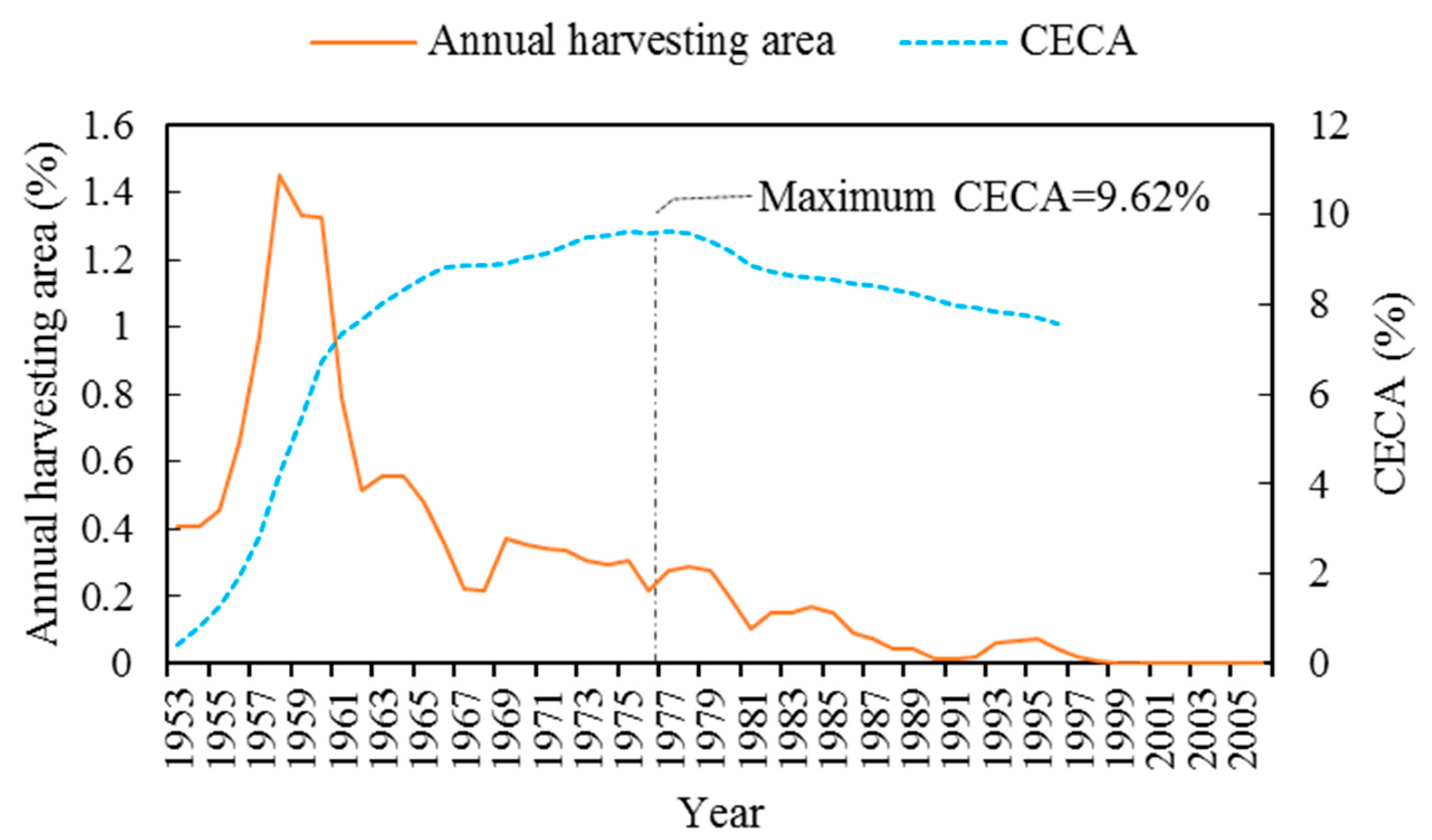
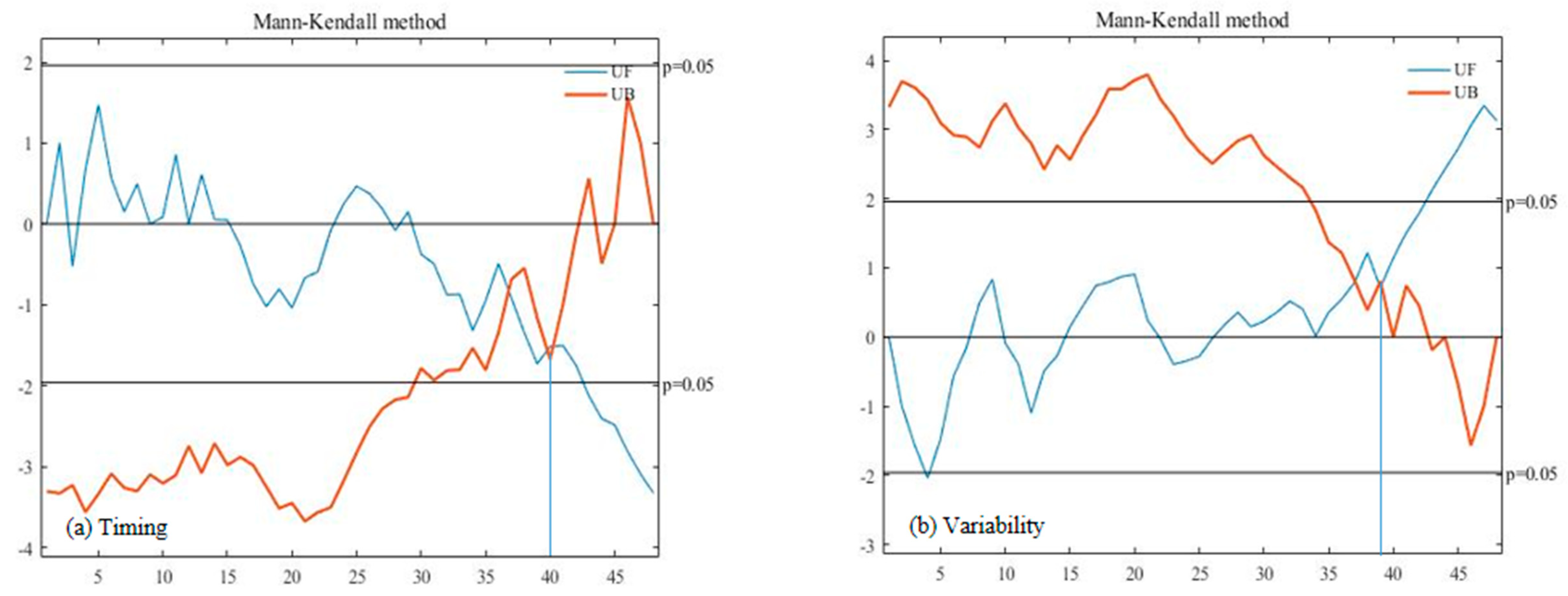










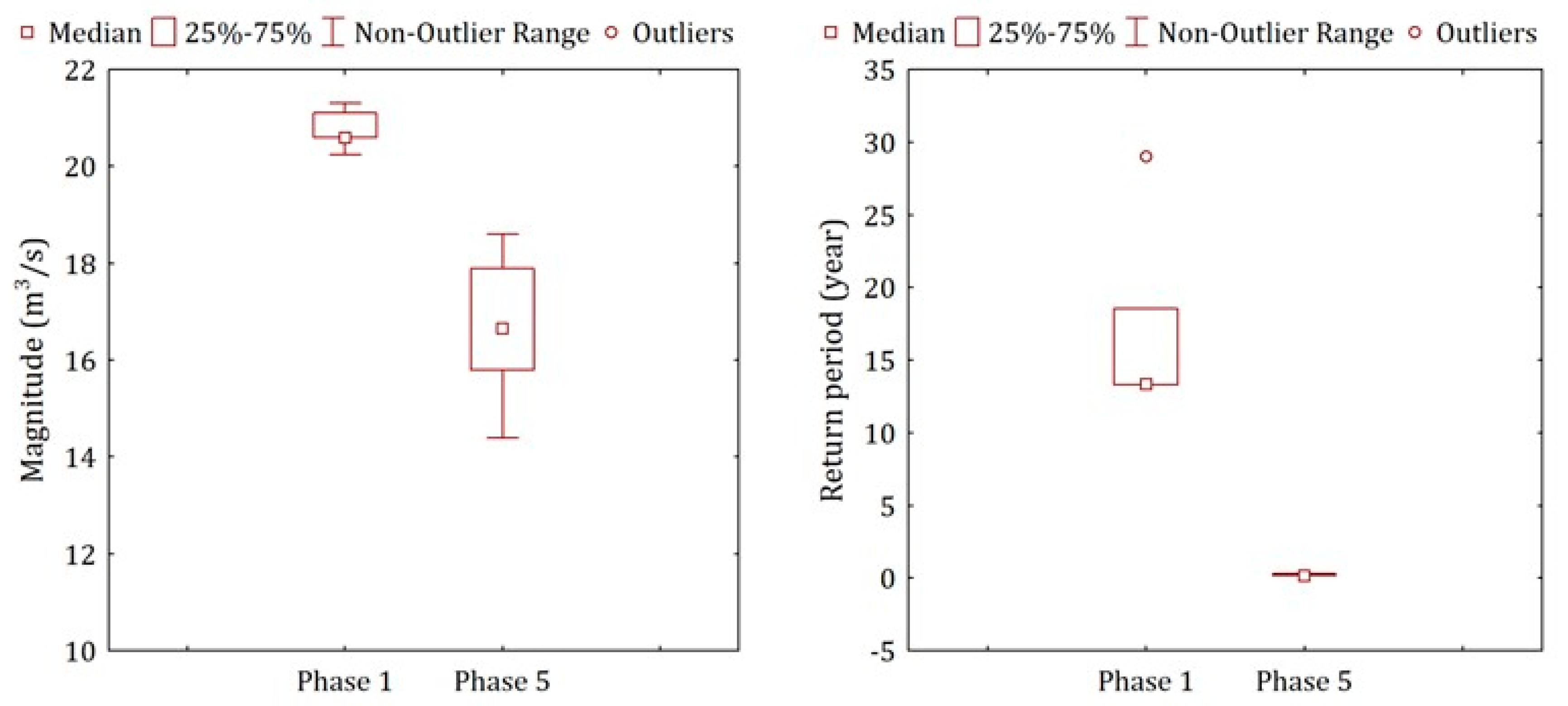
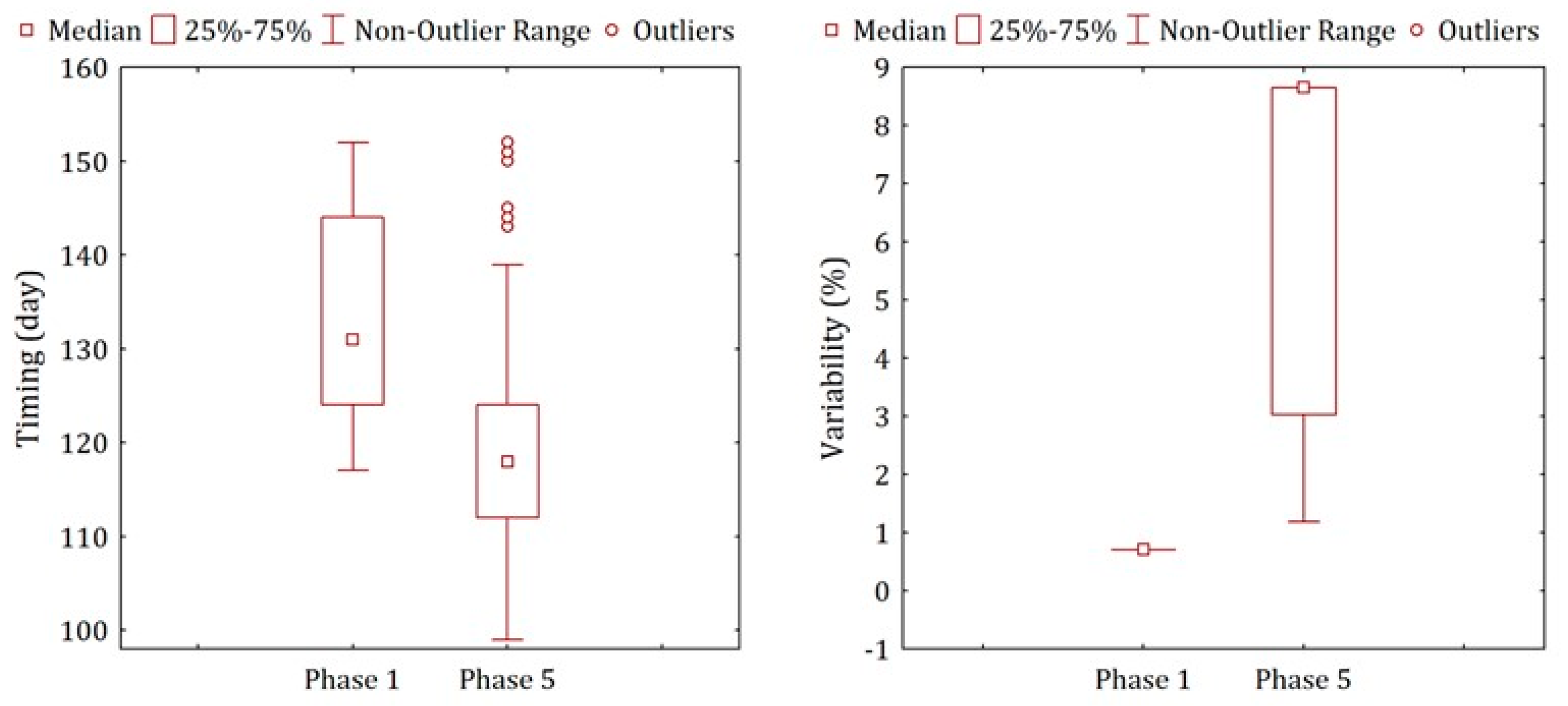
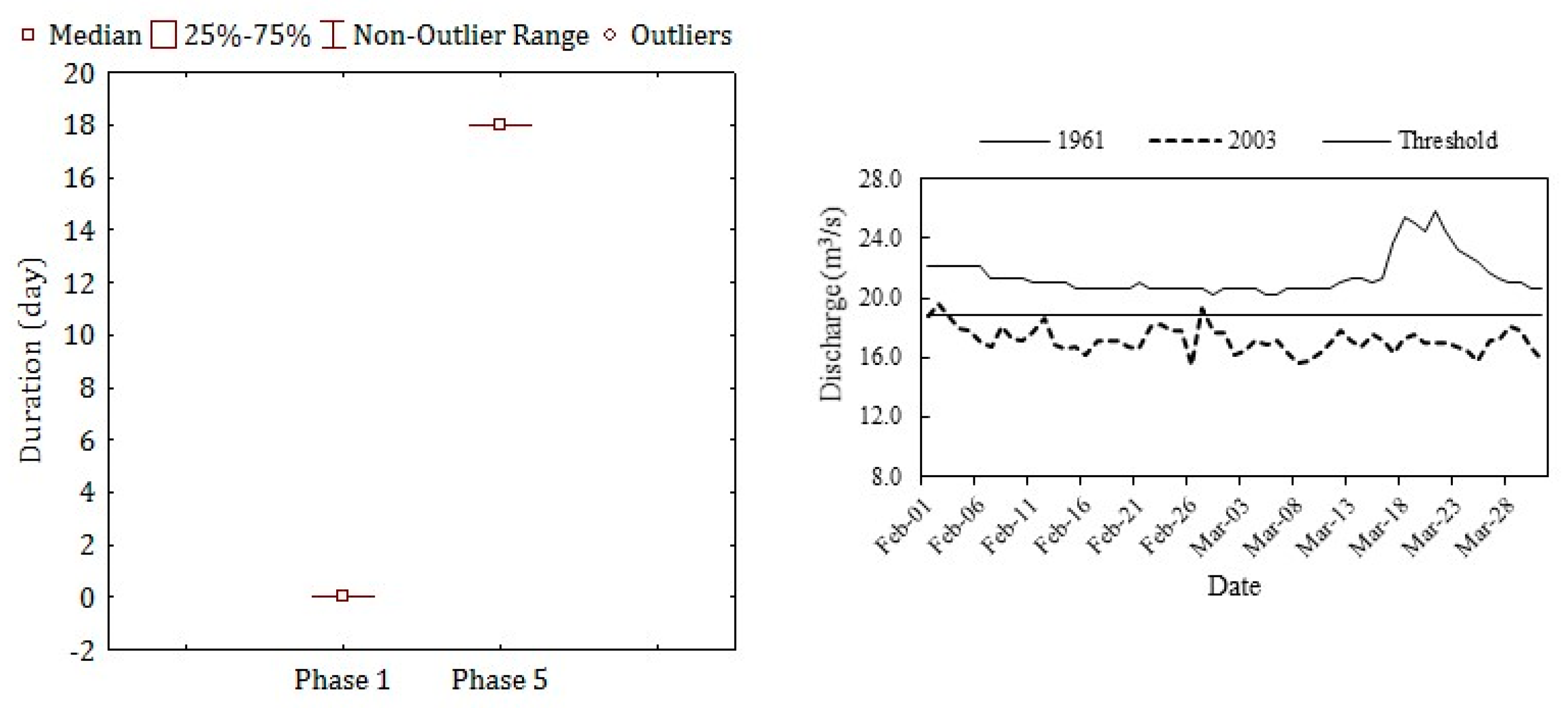
| Drivers for Hydrological Variations | Phase |
|---|---|
| Forest harvesting Climate variability (1959–1996) | Phase 1: 1959–1968 (The reference period without hydrological change due to forest harvesting) |
| Phase 2: 1969–1975 (The forest disturbed period with a moderate level of harvesting) | |
| Phase 3: 1976–1988 (The forest disturbed period with a low level of forest harvesting) | |
| Phase 4: 1989–1996 (The forest recovery period) | |
| Hydropower dam Climate variability (1997–2006) | Phase 5: 1997–2006 (The hydropower dam disturbed period without forest harvesting) |
| Groups | Pair | Year | Tmax-a | Tmean-ws | Rhu-lf | Relative Biases/% | |||
|---|---|---|---|---|---|---|---|---|---|
| Tmax-a | Tmean-ws | Rhu-lf | |||||||
| Phase 1 vs. Phase 2 | 1 | Reference | 1962 | 18.30 | 7.97 | 73.50 | |||
| Disturbed | 1973 | 18.60 | 7.88 | 78.50 | 1.64 | 1.05 | 6.80 | ||
| 2 | Reference | 1963 | 18.40 | 8.33 | 75.50 | ||||
| Disturbed | 1973 | 18.60 | 7.88 | 78.50 | 1.09 | 5.40 | 3.97 | ||
| 3 | Reference | 1966 | 17.50 | 7.97 | 78.00 | ||||
| Disturbed | 1971 | 18.80 | 7.90 | 81.50 | 7.43 | 0.38 | 4.49 | ||
| Phase 1 vs. Phase 3 | Reference | 1961 | 19.00 | 8.73 | 80.00 | ||||
| 1 | Disturbed | 1978 | 19.50 | 8.02 | 79.00 | 2.63 | 8.21 | 1.25 | |
| 2 | Disturbed | 1983 | 17.20 | 8.13 | 83.50 | 9.47 | 6.87 | 4.38 | |
| 3 | Disturbed | 1985 | 18.10 | 7.98 | 86.50 | 4.74 | 8.59 | 8.13 | |
| Reference | 1962 | 18.30 | 7.97 | 73.50 | |||||
| 4 | Disturbed | 1978 | 19.50 | 8.02 | 79.00 | 6.56 | 0.63 | 7.48 | |
| 5 | Disturbed | 1981 | 17.80 | 7.62 | 78.50 | 2.73 | 4.39 | 6.80 | |
| 6 | Reference | 1963 | 18.40 | 8.33 | 75.50 | ||||
| Disturbed | 1978 | 19.50 | 8.02 | 79.00 | 5.98 | 3.80 | 4.64 | ||
| 7 | Reference | 1964 | 19.30 | 8.47 | 85.00 | ||||
| Disturbed | 1985 | 18.10 | 7.98 | 86.50 | 6.22 | 5.71 | 1.76 | ||
| Reference | 1965 | 17.00 | 7.35 | 82.00 | |||||
| 8 | Disturbed | 1984 | 17.20 | 7.40 | 81.00 | 1.18 | 0.68 | 1.22 | |
| 9 | Disturbed | 1985 | 18.10 | 7.98 | 86.50 | 6.47 | 8.62 | 5.49 | |
| 10 | Disturbed | 1986 | 17.90 | 7.47 | 83.00 | 5.29 | 1.59 | 1.22 | |
| 11 | Disturbed | 1988 | 17.50 | 8.08 | 83.50 | 2.94 | 9.98 | 1.83 | |
| Phase 1 vs. Phase 4 | Reference | 1961 | 19.00 | 8.73 | 80.00 | ||||
| 1 | Disturbed | 1991 | 18.00 | 7.95 | 84.00 | 5.26 | 8.97 | 5.00 | |
| 2 | Disturbed | 1994 | 19.70 | 8.40 | 80.50 | 3.68 | 3.82 | 0.63 | |
| 3 | Disturbed | 1995 | 17.60 | 8.70 | 82.00 | 7.37 | 0.38 | 2.50 | |
| Reference | 1962 | 18.30 | 7.97 | 73.50 | |||||
| 4 | Disturbed | 1993 | 17.30 | 7.62 | 80.00 | 5.46 | 4.39 | 8.84 | |
| 5 | Disturbed | 1994 | 19.70 | 8.40 | 80.50 | 7.65 | 5.44 | 9.52 | |
| Reference | 1963 | 18.40 | 8.33 | 75.50 | |||||
| 6 | Disturbed | 1993 | 17.30 | 7.62 | 80.00 | 5.98 | 8.60 | 5.96 | |
| 7 | Disturbed | 1994 | 19.70 | 8.40 | 80.50 | 7.07 | 0.80 | 6.62 | |
| 8 | Disturbed | 1995 | 17.60 | 8.70 | 82.00 | 4.35 | 4.40 | 8.61 | |
| Reference | 1964 | 19.30 | 8.47 | 85.00 | |||||
| 9 | Disturbed | 1994 | 19.70 | 8.40 | 80.50 | 2.07 | 0.79 | 5.29 | |
| Groups | Pair | Year | Tmax-a | Tmean-ws | Rhu-lf | Relative Biases/% | |||
|---|---|---|---|---|---|---|---|---|---|
| Tmax-a | Tmean-ws | Rhu-lf | |||||||
| Phase 1 vs. Phase 5 | Reference | 1961 | 19.00 | 8.73 | 80.00 | ||||
| 1 | Disturbed | 2003 | 18.37 | 8.22 | 75.50 | 3.34 | 5.91 | 5.63 | |
| 2 | Disturbed | 2004 | 18.74 | 8.22 | 73.00 | 1.35 | 5.91 | 8.75 | |
| 3 | Disturbed | 2006 | 20.63 | 9.35 | 81.00 | 8.56 | 7.04 | 1.25 | |
| 4 | Reference | 1962 | 18.30 | 7.97 | 73.50 | ||||
| Disturbed | 2004 | 18.74 | 8.22 | 73.00 | 2.42 | 3.15 | 0.68 | ||
| 5 | Reference | 1963 | 18.40 | 8.33 | 75.50 | ||||
| Disturbed | 2004 | 18.74 | 8.22 | 73.00 | 1.86 | 1.39 | 3.31 | ||
| Variables | 1959–2006 | 1959–1988 | 1989–2006 | 1959–1996 | 1997–2006 | ||||||
|---|---|---|---|---|---|---|---|---|---|---|---|
| Kendall | Spearman | Kendall | Spearman | Kendall | Spearman | Kendall | Spearman | Kendall | Spearman | ||
| Precipitation | Annual | 0.103 | 0.154 | 0.127 | 0.186 | −0.046 | −0.053 | 0.169 | 0.250 | 0.422 | 0.576 |
| Dry season | 0.276 ** | 0.393 ** | 0.095 | 0.155 | 0.137 | 0.170 | 0.208 | 0.308 | 0.600 * | 0.733 * | |
| Wet season | 0.005 | −0.010 | 0.14 | 0.196 | −0.124 | −0.172 | 0.147 | 0.197 | 0.333 | 0.479 | |
| Low flow period | 0.141 | 0.206 | 0.088 | 0.113 | 0.320 | 0.443 | 0.013 | −0.003 | 0.333 | 0.455 | |
| Max temperature | Annual | 0.020 | 0.021 | −0.321 * | −0.490 ** | 0.414 * | 0.589 * | −0.233 * | −0.358 * | 0.156 | 0.236 |
| Dry season | −0.074 | −0.103 | −0.246 | −0.363 * | 0.333 | 0.474 * | −0.270 * | −0.395 * | −0.067 | −0.006 | |
| Wet season | 0.020 | 0.021 | −0.321 * | −0.490 ** | 0.414 * | 0.589 * | −0.233 * | −0.358 * | 0.156 | 0.236 | |
| Low flow period | 0.070 | 0.113 | −0.187 | −0.247 | 0.309 | 0.457 | −0.166 | −0.221 | −0.067 | −0.042 | |
| Mean temperature | Annual | 0.260 * | 0.397 ** | −0.245 | −0.347 | 0.589 ** | 0.781 ** | −0.130 | −0.183 | 0.114 | 0.146 |
| Dry season | 0.247 * | 0.377 ** | −0.135 | −0.217 | 0.428 * | 0.669 ** | −0.085 | −0.133 | −0.156 | −0.067 | |
| Wet season | 0.211 * | 0.313 * | −0.268 * | −0.371 * | 0.567 ** | 0.722 ** | −0.142 | −0.186 | 0.322 | 0.355 | |
| Low flow period | 0.112 | 0.181 | −0.143 | −0.208 | 0.176 | 0.269 | −0.116 | −0.166 | −0.244 | −0.321 | |
| Min temperature | Annual | 0.400 ** | 0.555 ** | 0.225 | 0.321 | 0.311 | 0.427 | 0.183 | 0.258 | −0.068 | −0.183 |
| Dry season | 0.400 ** | 0.555 ** | 0.225 | 0.321 | 0.311 | 0.427 | 0.183 | 0.258 | −0.068 | −0.183 | |
| Wet season | 0.214 * | 0.300 * | 0.166 | 0.221 | 0.325 | 0.467 | 0.060 | 0.078 | 0.067 | 0.115 | |
| Low flow period | 0.187 | 0.271 | 0.038 | 0.046 | 0.073 | 0.130 | 0.025 | 0.023 | −0.494 * | −0.584 | |
| Relative humidity | Annual | −0.202 * | −0.326 * | 0.156 | 0.228 | −0.678 ** | −0.840 ** | 0.178 | 0.230 | −0.511 * | −0.697 * |
| Dry season | −0.165 | −0.240 | 0.058 | 0.120 | −0.709 ** | −0.879 ** | 0.174 | 0.270 | −0.584 * | −0.748 * | |
| Wet season | −0.241 * | −0.367 * | 0.106 | 0.142 | −0.472 ** | −659 ** | 0.013 | 0.000 | −0.333 | −0.455 | |
| Low flow period | −0.071 | −0.121 | 0.127 | 0.175 | −0.488 ** | −0.708 ** | 0.183 | 0.254 | −0.200 | −0.309 | |
| Wind speed | Annual | −0.340 ** | −0.475 ** | 0.072 | 0.126 | −0.488 ** | −0.612 ** | −0.092 | −0.103 | 0.27 | 0.353 |
| Dry season | −0.333 ** | −0.470 ** | 0.042 | 0.09 | −0.393 * | −0.475 * | −0.106 | −0.132 | 0.422 | 0.624 | |
| Wet season | −0.308 ** | −0.427 ** | 0.121 | 0.216 | −0.472 ** | −0.580 * | −0.062 | −0.062 | 0.225 | 0.292 | |
| Low flow period | −0.292 ** | −0.406 ** | 0.048 | 0.052 | −0.247 | −0.299 | −0.116 | −0.152 | 0.449 | 0.596 | |
| Variables | 1959–2006 | 1959–1988 | 1989–2006 | 1959–1996 | 1997–2006 | |||||
|---|---|---|---|---|---|---|---|---|---|---|
| Kendall | Spearman | Kendall | Spearman | Kendall | Spearman | Kendall | Spearman | Kendall | Spearman | |
| Magnitude | −0.095 | −0.069 | −0.465 ** | −0.582 ** | −0.262 | −0.377 | −0.095 | −0.069 | −0.467 | −0.648 * |
| Return Period | −0.090 | −0.076 | −0.432 ** | −0.547 ** | −0.436 * | −0.572 * | −0.090 | −0.076 | −0.584 * | −0.729 * |
| Timing | −0.151 | −0.217 | −0.046 | −0.073 | −0.333 | −0.505 * | −0.151 | −0.217 | −0.289 | −0.406 |
| Variability | 0.149 | 0.213 | 0.046 | 0.091 | 0.425 * | 0.556 * | 0.149 | 0.213 | 0.200 | 0.236 |
| Duration | −0.029 | −0.049 | 0.414 ** | 0.486 ** | 0.375 * | 0.454 | −0.005 | −0.018 | 0.582 * | 0.726 * |
| Variables | Breakpoint | Year | Mann-Whitney U Test | |
|---|---|---|---|---|
| Z | p-Value | |||
| Timing | 40 | 1998 | 2.84 | <0.01 * |
| Variability | 39 | 1997 | −3.14 | <0.01 * |
| Groups | Variables | Difference | Mann-Whitney U Test | Wilcoxon | ||
|---|---|---|---|---|---|---|
| Z | p-Value | Z | p-Value | |||
| Phase 1 vs. Phase 2 | Ml (%) | −20.51 2.16 | 8.01 * | <0.01 | 6.39 * | <0.01 |
| RPl (y) | −15.95 10.99 | 1.73 | 0.08 | 1.60 | 0.11 | |
| TMl (d) | 0.39 4.99 | −0.2 | 0.84 | 0.44 | 0.66 | |
| CVl (%) | 0.91 0.77 | −0.58 | 0.56 | 1.07 | 0.29 | |
| DRl (d) | 12 8.49 | −1.15 | 0.25 | 1.41 | 0.16 | |
| Phase 1 vs. Phase 3 | Ml (%) | −19.71 1.34 | 11.55 * | <0.01 | 12.20 * | <0.01 |
| RPl (y) | −10.68 9.22 | 2.52 * | <0.05 | 2.93 * | <0.01 | |
| TMl (d) | −0.62 3.22 | 0.93 | 0.35 | 1.12 | 0.26 | |
| CVl (%) | 0.41 0.17 | −2.03 * | <0.05 | 2.93 * | <0.01 | |
| DRl (d) | 11.45 8.66 | −2.27 * | <0.05 | 2.37 * | <0.05 | |
| Phase 1 vs. Phase 4 | Ml (%) | −7.61 1.01 | 7.92 * | <0.01 | 10.70 * | <0.01 |
| RPl (y) | −13.24 7.79 | 1.88 | 0.06 | 2.52 * | <0.05 | |
| TMl (d) | 1.09 3.83 | 0.23 | 0.82 | 1.58 | 0.11 | |
| CVl (%) | 0.78 0.48 | −2.02 * | <0.05 | 2.67 * | <0.01 | |
| DRl (d) | 5.11 5.95 | −1.15 | 0.25 | 1.83 | 0.07 | |
| Groups | Variables | Difference | Mann-Whitney U Test | Wilcoxon | ||
|---|---|---|---|---|---|---|
| Z | p-Value | Z | p-Value | |||
| Phase 1 vs. Phase 5 | Ml (%) | −19.71 2.43 | 8.96 * | <0.01 | 8.24 * | <0.01 |
| RPl (y) | −17.05 6.30 | 1.96 * | <0.01 | 2.02 * | <0.05 | |
| TMl (d) | −14.87 5.99 | 5.27 * | <0.01 | 6.09 * | <0.01 | |
| CVl (%) | 5.41 3.35 | −1.97 * | <0.01 | 2.02 * | <0.05 | |
| DRl (d) | 18 0 | −1.96 * | <0.01 | 2.02 * | <0.05 | |
© 2020 by the authors. Licensee MDPI, Basel, Switzerland. This article is an open access article distributed under the terms and conditions of the Creative Commons Attribution (CC BY) license (http://creativecommons.org/licenses/by/4.0/).
Share and Cite
Jiang, Z.; Zhang, M.; Hou, Y. Both Forest Harvesting and Hydropower Dams Yielded Negative Impact on Low Flow Regimes in the Zagunao River Watershed, Southwest China. Forests 2020, 11, 787. https://doi.org/10.3390/f11080787
Jiang Z, Zhang M, Hou Y. Both Forest Harvesting and Hydropower Dams Yielded Negative Impact on Low Flow Regimes in the Zagunao River Watershed, Southwest China. Forests. 2020; 11(8):787. https://doi.org/10.3390/f11080787
Chicago/Turabian StyleJiang, Zhiwei, Mingfang Zhang, and Yiping Hou. 2020. "Both Forest Harvesting and Hydropower Dams Yielded Negative Impact on Low Flow Regimes in the Zagunao River Watershed, Southwest China" Forests 11, no. 8: 787. https://doi.org/10.3390/f11080787
APA StyleJiang, Z., Zhang, M., & Hou, Y. (2020). Both Forest Harvesting and Hydropower Dams Yielded Negative Impact on Low Flow Regimes in the Zagunao River Watershed, Southwest China. Forests, 11(8), 787. https://doi.org/10.3390/f11080787





